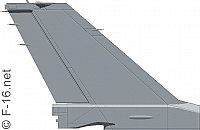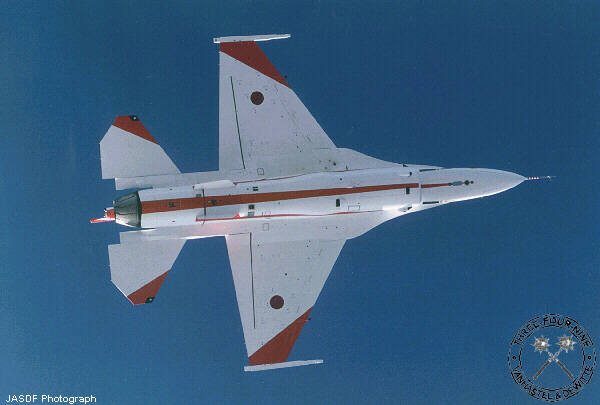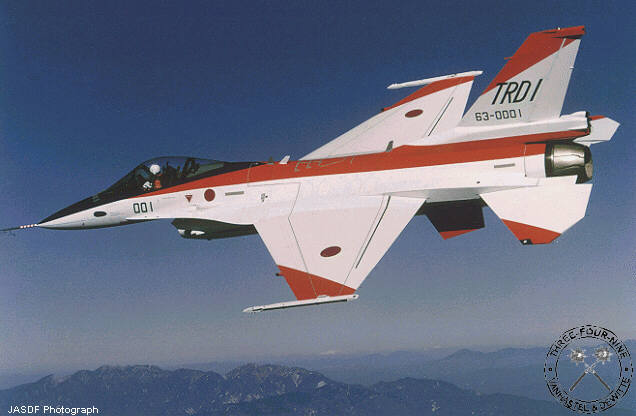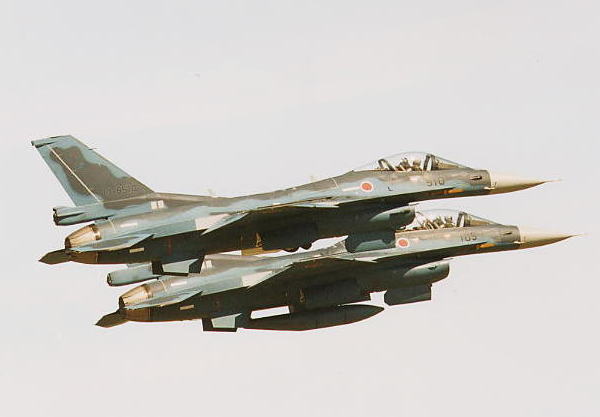History
The FS-X program
The FS-X's origins can be traced back to the early 1980's and the highly secretive Laboratory Three division of Japan's Technical Research and Development Institute (TRDI). There, studies were being carried out to investigate the options for an indigenous design, combining long range with maneuverability, to meet the particular requirements of the Japanese Air Self-Defense Force (JASDF).
It became clear that the pursuit of a completely indigenous design was unrealistic, and help was to be sought abroad. In October of 1987, the Japanese government announced that it was going to develop a derivative version of the F-16C known as the FS-X, to replace the JASDF's Mitsubishi F-1 support fighters, which were to be phased out of active service in the second half of the 1990's.
The program was launched in November 1988 with the signing of a Memorandum of Understanding between the governments of Japan and the United States, and marked the first joint fighter development program between Japan and the United States. The fighter was to be used exclusively by the Japan Air Self Defense Force and therefore development was completely funded by Japan. Primary missions of the new aircraft were be sea lane protection, beach defense and anti-invasion.
An important element in the specification of the F-2 was its ability to carry four ASM-1 or ASM-2 anti shipping missiles. This requirement dictated the need for the larger wing area and consequent changes. Although the F-2 is placed on interception duties as other fighter types in JASDF, it's main role is considered to be the destruction of enemy landing forces or enemy warships with these missles. The role is evident from the F-2's dark blue camo scheme, which is so different from other fighter types in JASDF.
The FS-X (Fighter Support Experimental) is being developed by Mitsubishi Heavy Industries as prime contractor with Lockheed Martin Tactical Aircraft Systems, Kawasaki Heavy Industries and Fuji Heavy Industries as principal subcontractors. Development workload has been split approximately 60/40, with the Japanese partners responsible for the larger share.
Structure & Avionics
The FS-X is quite similar in appearance to the F-16, but structural modifications include:
- Japanese-designed co-cured composite wing of greater span (1.7m wider) and root chord, with slightly less leading edge sweep. The composites give the wing added strength while reducing the weight;
- increased span tailplane;
- slightly reshaped and enlarged radome and forward fuselage (fuselage length has increased by 0.5m);
- slightly altered Leading-Edge Root Extensions (LERX).
Overall, the FS-X is substantially larger than the F-16, resulting in a maximum take-off weight of 49,000lb, compared to the F-16C's 42,000lb, although both are powered by the same 129kN (29,000lb)-thrust General Electric F110-129 turbofan engine. Other FSX structural-design changes include radar-absorbent material (RAM) applied to the aircraft's nose, wing leading-edges and engine inlet, the use of titanium in the tail and fuselage, the addition of a braking parachute and a two-piece canopy reinforced against large bird strikes.
The primary difference, although less conspicuous than the structural modifications, between the FS-X and the F-16 is in the use of Japanese domestic technology for much of the avionics, including:
- a new Mitsubishi Electric (Melco)-designed active phased-array radar comprising 800 3W gallium-arsenide transmit/receive modules;
- Yokogawa LCD multi-function display (MFD);
- Shimadzu holographic head-up display (HUD);
- internal Mitsubishi Electric integrated electronic warfare system;
- Japan Aviation Electronics laser inertial-navigation system backed-up with four conventional gyros;
Prototypes
The first of four FS-X flight-test aircraft (JASDF serial number 63-0001) rolled out of the "Mitsubishi Heavy Industries Komaki South Plant" in Japan on January 12th, 1995, and made its first flight on October 7th, 1995, at Mitsubishi's Nagoya test facilities. During the maiden flight (which lasted for 38 minutes), the 43-year-old test pilot, Yoshiyuki Watanabe, was at the controls.
The whole development program involves four flying prototypes (two single-seaters and two TFS-X combat-capable tandem two-seat variants), plus two structural-ground-test airframes.
Production
The Japanese congress approved the production program in mid 1996. Japan's government plans to procure a total of 130 F-2 aircraft, despite earlier significant questions in Japan regarding military needs and budgets, and rumours that the number would be cut to 70. Production deliveries of the F-2 will begin in 1999 and continue through 2011. In 2008, the Japanaese government decided to cut production after the 94th airframe is constructed.
Lockheed Martin's participation in the production of the Japan Air Self Defense Force's new F-2 fighter officially began in October of 1996, with the award of a $75 million contract from the F-2 prime contractor, Mitsubishi Heavy Industries (MHI). The contract was awarded to Lockheed Martin Tactical Aircraft Systems (LMTAS) of Fort Worth, Texas. LMTAS was the principal U.S. subcontractor during the development phase of the FS-X, and will continue to have major involvement in the production of the aircraft.
"Lockheed Martin has had an outstanding relationship with Mitsubishi Heavy Industries and with the Japan Defense Agency during the development phase of the F-2, and we look forward to continuing that relationship as we enter into production," said Don Jones, the Japan F-2 Program Director at Lockheed Martin Tactical Aircraft Systems. The initial contract award represents the beginning of what should be over $2.5 billion in contracts awarded to Lockheed Martin during the 15-year program.
Lockheed Martin will produce all the aircraft aft fuselages, all the wing leading-edge flaps and 8 of 10 left-hand wing boxes for the FS-X prototypes. The work will be performed at the company's Fort Worth plant, where it is expected to provide about 700 jobs at peak. Lockheed Martin is also providing all of the Stores Management Systems, some of the avionics support equipment and all of the data entry electronics units for the F-2.
Lockheed Martin has received extensive data on Japanese manufacturing processes during the aircraft development phase, as the result of two-way technology transfer agreements. The company will manufacture the F-2 wing boxes from composite materials using unique cocuring methods transferred to the United States by Japanese industry. Transfer of this technology started in 1990 with material testing.
Specifications
Engine: One General Electric F110-GE-129 turbofan, rated at 17,155 lb.s.t. dry and 28,984 lb.s.t. with afterburning.
Performance: Maximum short-endurance speed: Mach 2. (1315 mph) at 40,000 feet. Maximum sustained speed Mach 1.1 (725 mph) at sea level.
Dimensions: wingspan 35 feet 5.2 inches, length 50 feet 11 inches, height 15 feet, wing area 414 square feet.
Weights: 21,000 pounds empty, 26,450 pounds combat, 48,720 pounds maximum takeoff.
Please use this form to add any list any error or omissions you find in the above text.
Note: your comments will be displayed immediately on this page. If you wish to send a private comment to the webmasters, please use the Contact Us link.




